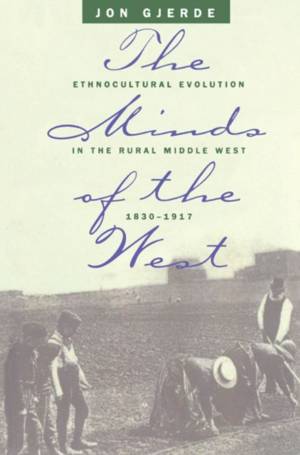
Je cadeautjes zeker op tijd in huis hebben voor de feestdagen? Kom langs in onze winkels en vind het perfecte geschenk!
- Afhalen na 1 uur in een winkel met voorraad
- Gratis thuislevering in België vanaf € 30
- Ruim aanbod met 7 miljoen producten
Je cadeautjes zeker op tijd in huis hebben voor de feestdagen? Kom langs in onze winkels en vind het perfecte geschenk!
- Afhalen na 1 uur in een winkel met voorraad
- Gratis thuislevering in België vanaf € 30
- Ruim aanbod met 7 miljoen producten
Zoeken
Minds of the West
Ethnocultural Evolution in the Rural Middle West, 1830-1917
Jon Gjerde
Paperback | Engels
€ 69,45
+ 138 punten
Omschrijving
In the century preceding World War I, the American Middle West drew thousands of migrants both from Europe and from the northeastern United States. In the American mind, the region represented a place where social differences could be muted and a distinctly American culture created. Many of the European groups, however, viewed the Midwest as an area of opportunity because it allowed them to retain cultural and religious traditions from their homelands.
Jon Gjerde examines the cultural patterns, or "minds," that those settling the Middle West carried with them. He argues that such cultural transplantation could occur because patterns of migration tended to reunite people of similar pasts and because the rural Midwest was a vast region where cultural groups could sequester themselves in tight-knit settlements built around familial and community institutions.
Gjerde compares patterns of development and acculturation across immigrant groups, exploring the frictions and fissures experienced within and between communities. Finally, he examines the means by which individual ethnic groups built themselves a representative voice, joining the political and social debate on both a regional and national level.
Jon Gjerde examines the cultural patterns, or "minds," that those settling the Middle West carried with them. He argues that such cultural transplantation could occur because patterns of migration tended to reunite people of similar pasts and because the rural Midwest was a vast region where cultural groups could sequester themselves in tight-knit settlements built around familial and community institutions.
Gjerde compares patterns of development and acculturation across immigrant groups, exploring the frictions and fissures experienced within and between communities. Finally, he examines the means by which individual ethnic groups built themselves a representative voice, joining the political and social debate on both a regional and national level.
Specificaties
Betrokkenen
- Auteur(s):
- Uitgeverij:
Inhoud
- Aantal bladzijden:
- 442
- Taal:
- Engels
Eigenschappen
- Productcode (EAN):
- 9780807848074
- Verschijningsdatum:
- 22/02/1999
- Uitvoering:
- Paperback
- Formaat:
- Trade paperback (VS)
- Afmetingen:
- 156 mm x 235 mm
- Gewicht:
- 657 g

Alleen bij Standaard Boekhandel
+ 138 punten op je klantenkaart van Standaard Boekhandel
Beoordelingen
We publiceren alleen reviews die voldoen aan de voorwaarden voor reviews. Bekijk onze voorwaarden voor reviews.









